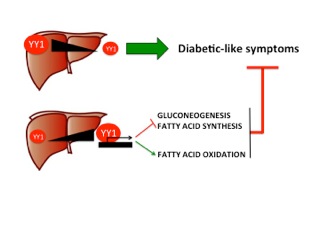 Insulin resistance is a clinical symptom of type 2 diabetes that causes profound dysregulation of glucose and lipid metabolism. In the diabetic liver, insulin no longer suppresses glucose production via the intracellular signaling or transcriptional pathways that typically suppress gluconeogenic gene expression. However, resistance to insulin does not suppress fatty acid synthesis via the transcription factor SREBP1c, resulting in lipid accumulation and exacerbating diabetic symptoms. In a new article in Molecular Endocrinology, the Puigserver Lab shows that by binding to target promoters, the transcription factor Yin Yang 1 (YY1) represses expression of genes encoding enzymes for glucose and fatty acid synthesis. At the same time, YY1 activates expression of genes encoding fatty acid oxidation enzymes. As a consequence, decreased genetic dosage of YY1 in mouse liver leads to diabetic-like symptoms such as hyperglycemia, dyslipidemia, hepatic lipid accumulation, and insulin resistance. This phenotype mimics diabetic symptoms and makes targeting YY1 an attractive approach for treating insulin-resistant diabetes.
Insulin resistance is a clinical symptom of type 2 diabetes that causes profound dysregulation of glucose and lipid metabolism. In the diabetic liver, insulin no longer suppresses glucose production via the intracellular signaling or transcriptional pathways that typically suppress gluconeogenic gene expression. However, resistance to insulin does not suppress fatty acid synthesis via the transcription factor SREBP1c, resulting in lipid accumulation and exacerbating diabetic symptoms. In a new article in Molecular Endocrinology, the Puigserver Lab shows that by binding to target promoters, the transcription factor Yin Yang 1 (YY1) represses expression of genes encoding enzymes for glucose and fatty acid synthesis. At the same time, YY1 activates expression of genes encoding fatty acid oxidation enzymes. As a consequence, decreased genetic dosage of YY1 in mouse liver leads to diabetic-like symptoms such as hyperglycemia, dyslipidemia, hepatic lipid accumulation, and insulin resistance. This phenotype mimics diabetic symptoms and makes targeting YY1 an attractive approach for treating insulin-resistant diabetes.